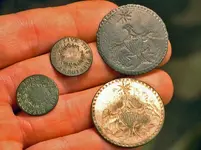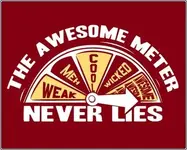tigerbeetle
Full Member
- Joined
- Jan 2, 2009
- Messages
- 166
- Reaction score
- 275
- Golden Thread
- 0
- Location
- Jersey Shore
- Detector(s) used
- Many -- Fisher, White's, Minelab, Cobra, others
- Primary Interest:
- Metal Detecting
Here's my current collection of GW inauguration buttons. I found my third, small (vest?) "Long Live the President" button last month. It's soon to be lightly restored. I'll add a photo of that latest button in here soon. I'll also try to get a shot of the backs of these pictured buttons.
The best of the lot is the larger silver button, a rare variety with nearly 80 percent of the silver plating still showing. That's astounding for a dug button. The back of that button took the wear, losing all the plating and the shaft. My latest small button was pretty ragged when first dug. I'm hoping it restores well.
It's all how the button falls. The side facing down can shine, despite over 200 years of being buried. The up-facing side takes all the chemical leachates trickling down through the soil. Disturbingly, never has so much acid rained down. There's now something of an urgency to find great buttons like these before the ever-increasing presence of nitric and sulfuric acids does its dirty work -- be it to coins or buttons. Of course, the likes of fertilizers, dumped household chemicals and road runoff are far from kind to buried objects.
By the by, I sold my first-ever dug GW button, a large one that was very "environmentally damaged." The offer was quite right. I found it near (but not illegally in) Batsto, NJ.
While GW buttons aren't as rare as once thought, they remain among the most valuable buttons on the planet. What's more, the growing number of GW specimens -- many being found by detectorists in NJ -- have created an increasingly discerning collectorship. Many aficionados are hellbent on upgrading their collections or collecting as many varieties as possible. In the long run, this should keep the demand very healthy.
While I'm holding on to my GW buttons, I believe the best way to sell any dug or otherwise discovered GW buttons is through higher end auctions, like Stacks. Sure, the auctioneer takes a piece of the pie but the most informed and deep-pocketed buyers bid in such auctions. I also prefer when a buyer gets a close up look at just what is being sold. The likes of eBay adds so many long-distance variables that the price often reflects bidders' uncertainties.

The best of the lot is the larger silver button, a rare variety with nearly 80 percent of the silver plating still showing. That's astounding for a dug button. The back of that button took the wear, losing all the plating and the shaft. My latest small button was pretty ragged when first dug. I'm hoping it restores well.
It's all how the button falls. The side facing down can shine, despite over 200 years of being buried. The up-facing side takes all the chemical leachates trickling down through the soil. Disturbingly, never has so much acid rained down. There's now something of an urgency to find great buttons like these before the ever-increasing presence of nitric and sulfuric acids does its dirty work -- be it to coins or buttons. Of course, the likes of fertilizers, dumped household chemicals and road runoff are far from kind to buried objects.
By the by, I sold my first-ever dug GW button, a large one that was very "environmentally damaged." The offer was quite right. I found it near (but not illegally in) Batsto, NJ.
While GW buttons aren't as rare as once thought, they remain among the most valuable buttons on the planet. What's more, the growing number of GW specimens -- many being found by detectorists in NJ -- have created an increasingly discerning collectorship. Many aficionados are hellbent on upgrading their collections or collecting as many varieties as possible. In the long run, this should keep the demand very healthy.
While I'm holding on to my GW buttons, I believe the best way to sell any dug or otherwise discovered GW buttons is through higher end auctions, like Stacks. Sure, the auctioneer takes a piece of the pie but the most informed and deep-pocketed buyers bid in such auctions. I also prefer when a buyer gets a close up look at just what is being sold. The likes of eBay adds so many long-distance variables that the price often reflects bidders' uncertainties.

Upvote
8







